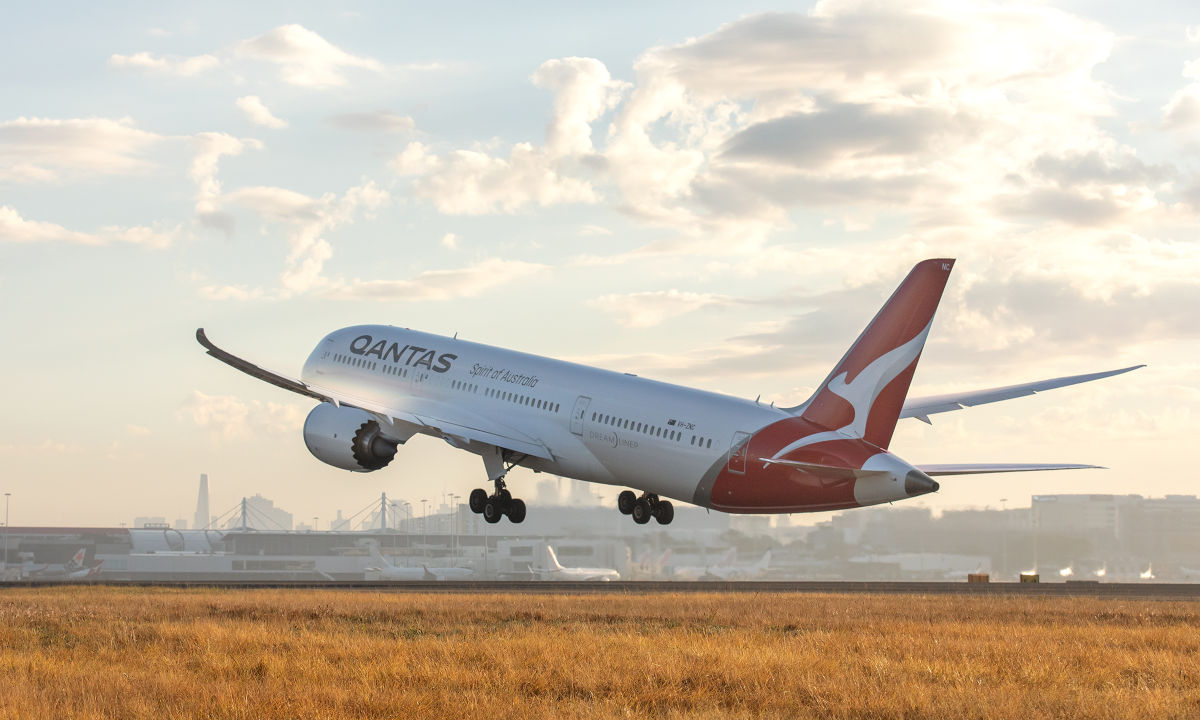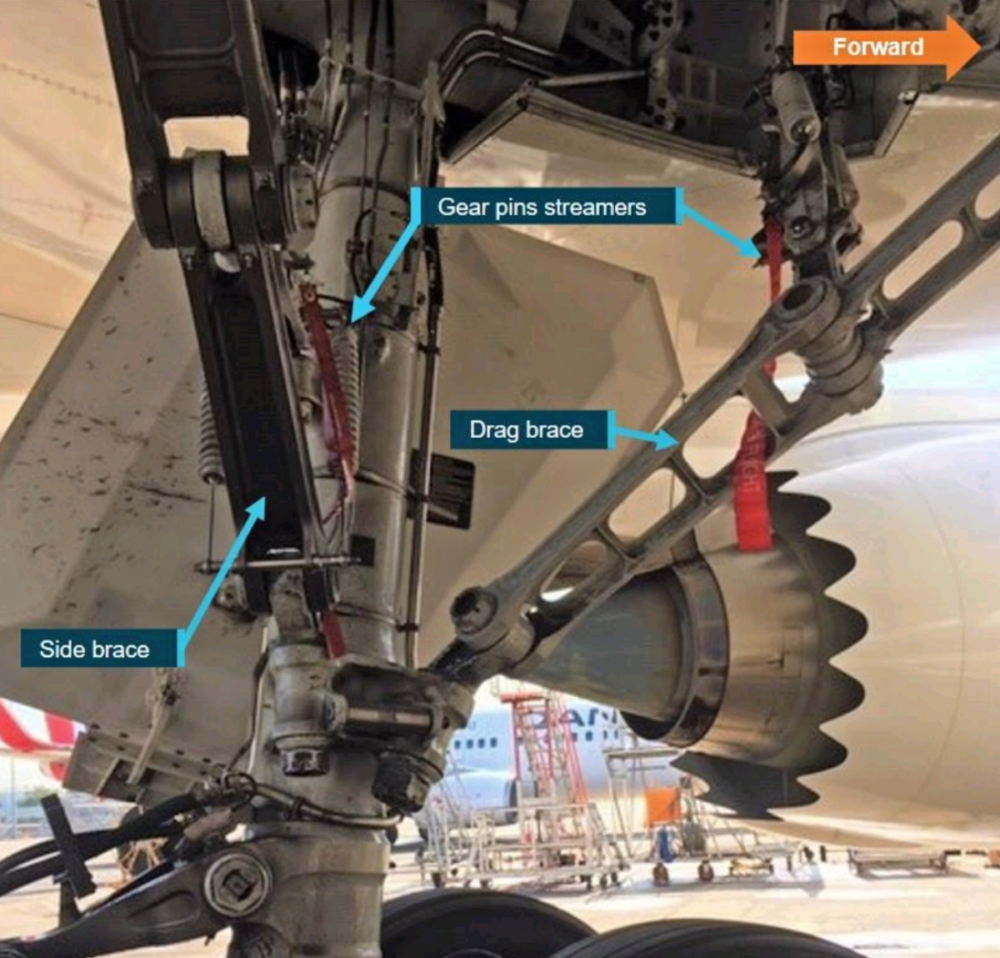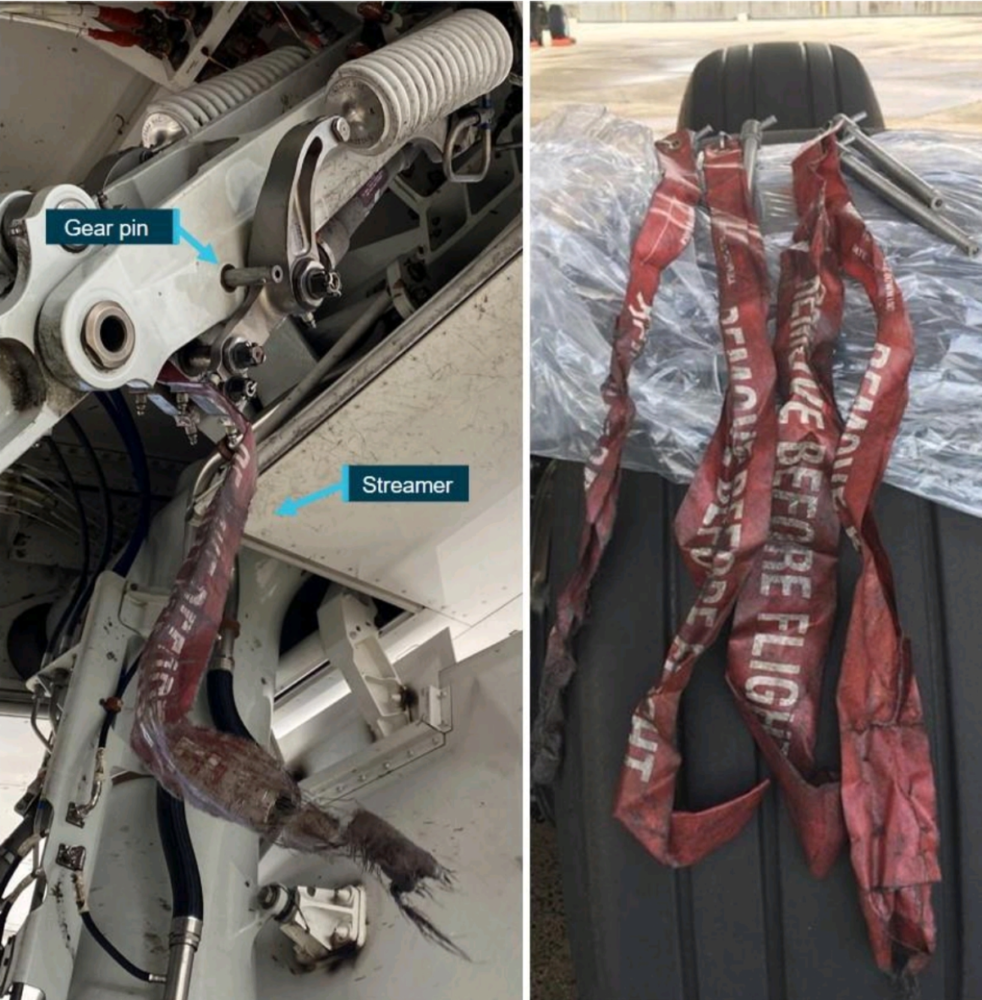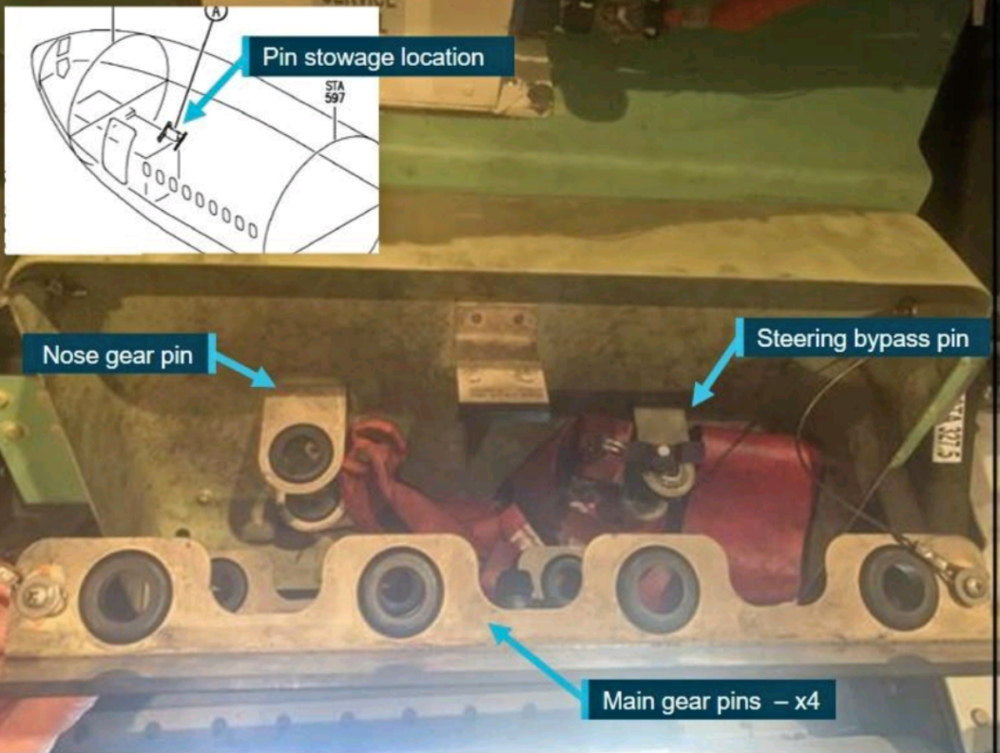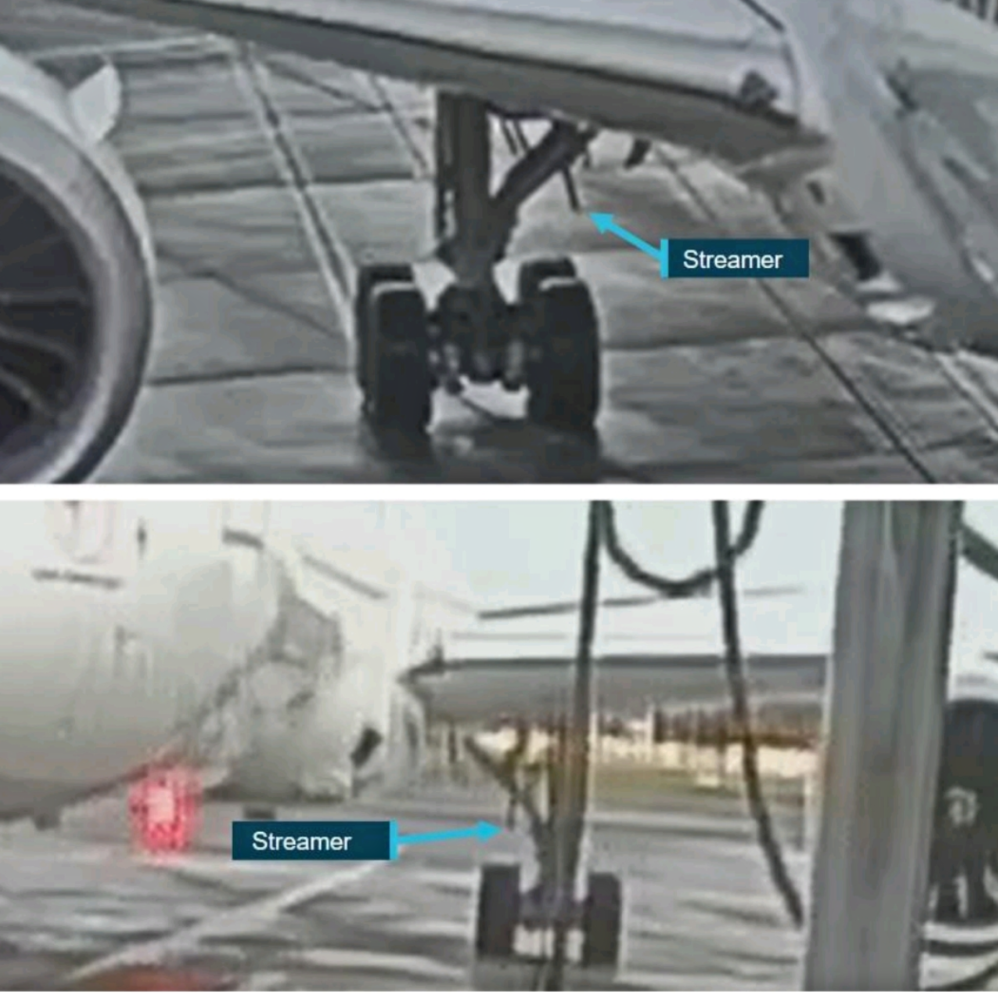An Australian Transport Safety Bureau (ATSB) investigation has found the failure to remove two downlock pins before departure prevented the main landing gear of a Qantas Boeing 787-9 from retracting after takeoff earlier this year.
Preflight inspections did not spot two downlock pins
The aircraft, VH-ZNH, was operating QF645 from Sydney to Perth on Monday, June 21, 2021. There were 106 passengers and 13 crew on the flight. After taking off, the pilots selected UP on the aircraft’s landing gear lever.
They then received a warning indicating that neither main landing gear had retracted to the ‘up and locked’ position. Working through the aircraft’s electronic checklist did not resolve the issue. The pilots then selected the landing gear lever to DOWN. There was a positive gear extension indication, and the aircraft returned to Sydney for a safe landing.
A subsequent ATSB investigation found two of five landing gear downlock pins were not removed after the aircraft before departure. Further, pins were also not identified during subsequent preflight inspections.
"Pins are inserted into the nose and main landing gear when the aircraft is on the ground to prevent inadvertent gear retraction during maintenance or towing,” ATSB Director Transport Safety Stuart Macleod said in a statement.
“In this case, two of the pins, one of the two for each main landing gear, had not been removed after towing and prior to the flight. In addition, subsequent preflight inspections by the flight and dispatch crew did not identify that the pins remained in place prior to departure.”
Stay informed: Sign up for our daily and weekly aviation news digests.
Towing crew remove three of five downlock pins on Qantas 787
Aircraft downlock pins safely lock a plane's landing gear in place and are used when aircraft are on the ground. Downlock pins prevent the downlock struct from folding. They are manually installed after an aircraft arrives at the gate or other parking spot and removed before the plane departs.
Downlock pins have streamers attached to them, serving as a visual prompt. In this case, red ‘remove before flight’ streamers were attached to the Dreamliner.
According to the ATSB investigation, the ground crew removed three of the five downlock pins on VH-ZNH after towing it to Gate 11 at the Qantas domestic terminal in Sydney for final pre-departure checks and boarding.
The senior ground crew member looking after the jet removed the nose gear downlock pin, then walked to the aircraft's rear and removed one gear pin from the right main gear. At the same time, one of the wing walkers removed a gear pin from the left main gear. Neither the senior ground crew member nor the wing walker had towed a 787 before.
On the plane was a licensed 787 aircraft maintenance engineer (LAME), in the role of flight deck operator and an aircraft maintenance engineer (AME). What followed was a combination of miscommunication, misunderstanding, and inexperience.
A combination of miscommunication, inexperience, & misunderstandings
When the LAME and AME later exited the aircraft, they noted that the nose gear pin had been removed. The LAME reported that they looked down towards the main gear and did not identify any streamers associated with the gear pins.
As a result, the LAME directed the AME to confirm all the gear pins had been stowed in the electrical equipment center (EEC) located just aft of the nose gear. This is where the five downlock pins are meant to be stored on this aircraft type. The LAME signed for the removal and storage of the landing gear pins on the electronic and paper technical logs.
But before then, in a conversation over the aircraft's intercom system, the AME had relayed to the senior ground crew member he could leave the removed pins on the nose gear, and the LAME would stow them when the aerobridge arrived and they could exit the aircraft.
But the inexperienced senior ground crew member opened the EEC anyway. However, the ladder he was using was not high enough to see into the pin stowage location. He felt around and physically identified pin stowage holes, and stowed the three downlock pins he had. He then closed the EEC, returned the ladder, and along with the wing walker, left the plane.
The LAME and AME remained on the Dreamliner for a further 20 minutes. Upon leaving, the LAME asked the AME to check ground crew had correctly stowed the downlock pins. Again, there was a problem with the ladder's height. The AME couldn't see into the stowage location, but he could reach in, and he felt the downlock pins there. On this basis, the LAME signed off on the storage.
Inspection lapses continue after flight crew arrive
After the LAME and AME left, the pilots arrived. Flying QF645 that day was a Captain, a First Officer, and a Second Captain (filling the relief officer role). They noted the endorsement in the technical logs that the gear pins had been removed and stowed.
The Second Captain conducted the external inspection around 40 minutes before the flight was pushed back. That inspection, which included landing gear system checks, did not identify the two remaining downlock pins. A Swissport supervisor conducting a final check before departure did not notice the downlock pins either.
The Boeing 787-9 took off without incident. It was only in the air when attempting to retract the landing gear that the alerts sounded. The two main landing gear sets remained stuck "in transit." Further troubleshooting did not resolve the problem.
But the landing gear could successfully extend down. Around 35 minutes after takeoff, after circling over the ocean just off Sydney, VH-ZNH returned to Sydney safely. After going to the gate, Qantas engineering employees subsequently identified two landing gear pins, one in each main gear, remained in place.
ATSB findings & Qantas' response
The ATSB investigation found the second gear pin on each main landing gear was not removed. The missed gear pin streamers may have been stuck on the gear from a combination of grime and the recent wet and windy conditions.
The post-incident inspection found all four main gear pins’ streamers to be in place, but dull and frayed. Their condition before the flight could not be conclusively determined.
“‘Remove before flight’ streamers are visual reminders to remove covers and lockout devices prior to flight, but can be subject to varying environmental conditions that can reduce their visibility,” Mr Macleod said.
“Expectation can also affect your ability to identify these warning devices. If you are not expecting to see a ‘remove before flight’ streamer, you are significantly less likely to detect one that is present.
“The same principle can also prevent the discovery of damaged and/or missing components.”
Following the incident, Qantas said it would work to relocate the gear pin stowage on its Dreamliners to the flight deck. This will help facilitate both storage and verification and is what happens across the rest of its fleet.
Qantas also distributed a memo to its engineering, flight, and ramp staff to highlight the quantity and location of the gear pins on the Boeing 787 and the importance of following the documented ramp, preflight, and dispatch procedures.
The memo also emphasized the importance of checking the pin locations rather than relying on ‘remove before flight’ streamers to identify pins after towing.

